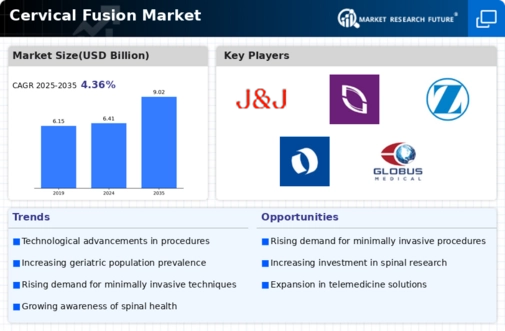Market Growth Projections
The Global Cervical Fusion Market Industry is poised for substantial growth, with projections indicating a market size of 6.41 USD Billion in 2024 and an anticipated increase to 9.02 USD Billion by 2035. This growth trajectory suggests a compound annual growth rate of 3.15 percent from 2025 to 2035. Such figures reflect the increasing demand for cervical fusion procedures driven by various factors, including technological advancements, rising healthcare expenditures, and an aging population. As the market evolves, stakeholders are likely to explore new opportunities and innovations to cater to the growing patient population.
Increasing Healthcare Expenditure
The Global Cervical Fusion Market Industry is benefiting from rising healthcare expenditures across various regions. Governments and private sectors are investing more in healthcare infrastructure, which includes advanced surgical facilities and training for medical professionals. This trend is particularly evident in emerging economies, where healthcare spending is expected to grow significantly. For instance, countries in Asia-Pacific are projected to increase their healthcare budgets by an average of 5 percent annually over the next decade. Such investments are likely to enhance access to cervical fusion procedures, thereby expanding the market and supporting its anticipated compound annual growth rate of 3.15 percent from 2025 to 2035.
Rising Incidence of Cervical Disorders
The Global Cervical Fusion Market Industry is experiencing growth due to the increasing prevalence of cervical disorders, such as degenerative disc disease and cervical spondylosis. These conditions are becoming more common, particularly among aging populations. For instance, studies indicate that approximately 30 percent of individuals over the age of 65 may experience some form of cervical spine disorder. This rising incidence necessitates effective surgical interventions, including cervical fusion procedures, thereby driving market demand. As the market evolves, it is projected to reach a valuation of 6.41 USD Billion in 2024, reflecting the urgent need for innovative treatment solutions.
Growing Awareness and Education on Spine Health
There is a notable increase in awareness regarding spine health, which is positively impacting the Global Cervical Fusion Market Industry. Educational campaigns and initiatives aimed at promoting spinal health are becoming more prevalent, leading to early diagnosis and treatment of cervical disorders. For instance, organizations are conducting workshops and seminars to educate the public about the importance of maintaining spinal health and recognizing symptoms of cervical issues. This heightened awareness is likely to drive more individuals to seek surgical options, including cervical fusion, thereby contributing to the overall growth of the market as it adapts to changing patient needs.
Technological Advancements in Surgical Techniques
Technological innovations are significantly influencing the Global Cervical Fusion Market Industry. The introduction of minimally invasive surgical techniques, such as endoscopic and robotic-assisted surgeries, has transformed traditional approaches to cervical fusion. These advancements not only enhance surgical precision but also reduce recovery times and improve patient outcomes. For example, robotic-assisted surgeries have shown to decrease hospital stays by up to 30 percent compared to conventional methods. As these technologies continue to develop, they are likely to attract more patients seeking effective and less invasive treatment options, contributing to the market's projected growth to 9.02 USD Billion by 2035.
Aging Population and Demand for Surgical Solutions
The demographic shift towards an aging population is a crucial driver for the Global Cervical Fusion Market Industry. As individuals age, the likelihood of developing cervical spine disorders increases, leading to a higher demand for surgical interventions. In many developed nations, the proportion of individuals aged 65 and older is expected to rise significantly, creating a larger patient pool for cervical fusion procedures. This demographic trend is likely to push the market towards a valuation of 9.02 USD Billion by 2035, as healthcare systems adapt to meet the needs of an older population requiring effective surgical solutions.
















Leave a Comment